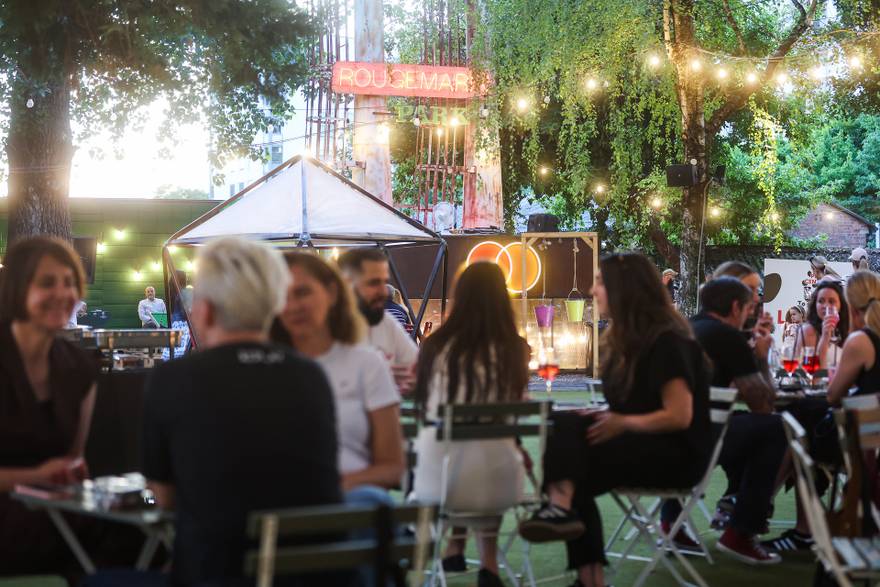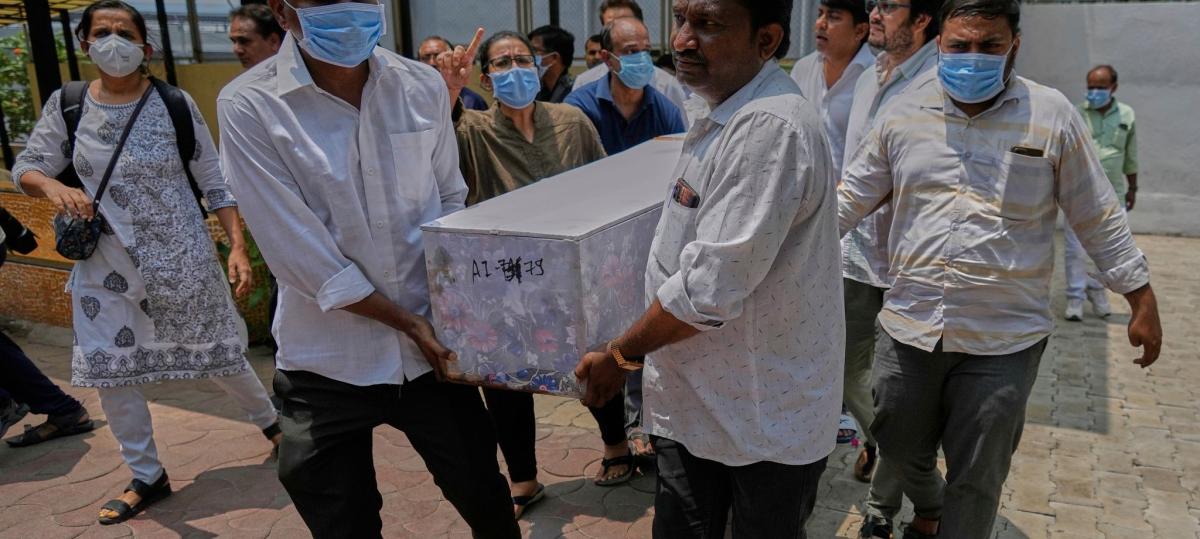The National Education Museum shows how the spirit of the times puts his mark on education. But how long?
/s3/static.nrc.nl/images/gn4/stripped/data131496426-20a9b5.jpg|https://images.nrc.nl/Q9HpKfKpDmfeMgHTrYKvmy4zXVE=/1920x/filters:no_upscale()/s3/static.nrc.nl/images/gn4/stripped/data131496426-20a9b5.jpg|https://images.nrc.nl/mm7lKYwVt21BRycoKDpwDlHU_ts=/5760x/filters:no_upscale()/s3/static.nrc.nl/images/gn4/stripped/data131496426-20a9b5.jpg)
When Curator Jacques Dane of the National Education Museum gives a tour, he often walks past the school plates hanging on the ceiling in rows. He then points to a print of a colonial plantation, which hung in classrooms in the twentieth century. And he asks the visitors to guess which course the album belongs.
History, it usually sounds.
But anyone who takes the teachers’ manual – in the opinion of DANE more interesting than the album itself – sees that the slaves who attract attention on the former school plate are only a side issue. Biology teachers used the print in lessons about botany, cross -pollination and in particular the tobacco plant.
« Students who have had lessons about colonialism, » says Dane, « immediately see the man in the white tropical costume with a whip in his hand and black people around him. They see oppression and colonialism in this. While visitors above eighty thinking is about the tobacco plant. »
It illustrates for DANE in a nutshell to which the National Education Museum in Dordrecht is on Earth. The historical heritage, memories, the nostalgia. But more to show how the spirit of the times constantly leaves his mark on education and how that has influenced generations.
How long the largest education collection in the Netherlands can still be admired is uncertain. Both from the municipality and from The Hague, the subsidy flow threatens to be stopped, with which 80 percent of the income dries up at the end of the year. The museum recently announced that it would be racing on a closure.
The concerns came when Dordrecht put the museum on a list with possible austerity measures. There is still something lobbying, thought Peter Vrancken, chairman of the Supervisory Board. And so in March he visited the other subsidy provider, the Ministry of Education, in the hope that people would have an extra game there.
The answer fell raw on the roof. « The first thing they said, » Ho, we’re going to stop. And By the way: We have already told the municipality. « » After a walk of an hour, the consequences started to fall. « Then you will get a headache attack. You get stuck on two sides. »
About 30,000 visitors a year, from school classes, day trippers and the elderly who come to sniff the smell of the past into scientists and learning aids makers
350,000 objects
« Entire tribes could get this up, » says curator Dane at a wooden reading board, with the winged words with which countless school children have learned to read: monkey, nut, mies. The Catholics had their variant (monkey, rose, sieve), for Jewish children there was the Hebrew counterpart.
The museum’s collection consists of 350,000 objects, from school diaries and griffels to gym equipment and textbooks. But it’s not just about nostalgia, the curator emphasizes. « There is educational innovation behind each object. AAP, NOT, Mies is still a blueprint for contemporary reading education. »
The museum attracts around thirty thousand visitors every year. They are school classes, day trippers, elderly people who come to sniff the smell of their former classroom, but also scientists and learning resources makers who go back to the methods with which children used to learn to read, write and count.
DANE points to the draft text of the Mammoet Act – one of the most radical post -war educational reforms – which is below the glass. The notes of education minister Jo Cals (KVP) are still legible. « If we say that with the museum the Dutch educational memory also disappears, we don’t just mean that visually. »
Why is that bad? Imagine, says Dane. « All your photo albums are thrown away. Everything that can be found about your family. Then you lose your visual memory. That is no different in politics. We are on the shoulders of our predecessors. It is important to know where you come from, how things have grown. »
/s3/static.nrc.nl/images/gn4/stripped/data131496438-cde2dd.jpg|https://images.nrc.nl/v_nG07TpJ19uwOx9VwAz3iWtz1k=/1920x/filters:no_upscale()/s3/static.nrc.nl/images/gn4/stripped/data131496438-cde2dd.jpg|https://images.nrc.nl/rfZTDXd86Rvny4Ks5J2DKFkcIoM=/5760x/filters:no_upscale()/s3/static.nrc.nl/images/gn4/stripped/data131496438-cde2dd.jpg)
Cheese
The museum is hit on two fronts. First of all, the ‘canyon year’, about which municipalities also after the allowance from the cabinet Not being rested yet, local authorities for major choices. The nomination for closure contains a swimming pool in Dordrecht, a branch of the library and therefore also the museum.
« Unfortunately, » says culture alderman Rik van der Linden (ChristenUnie-SGP) that the museum that Dordrecht still received thirteen years ago with open arms should probably close its doors again. « It is an important museum, with a unique collection. And for many people reason to visit our city. »
The city council decides in July on the list of austerity options that has been drawn up. But that there are blows, according to Van der Linden, is inevitable. « You first get a cheese slicer through your own organization. But you just don’t make it. Whatever you decide, the cutbacks will take place in places where you will notice it. »
In addition, the cutbacks that initially meet the ministries, but will also be felt outside The Hague. In addition to the cutbacks in education, the government wants to shorten 22 percent on the civil service in the coming years. That is not without reducing the workforce.
« The central government must do it with fewer people in the coming years, » the ministry said in a written response. « That means that we have to make sharp choices in what we can and cannot do anymore. » The ministry says that it cannot offer the ‘extra commitment and money’ that requires the financial situation of the museum.
Read also
Sex in the Education Museum
Head above water
For the Education Museum, history seems to be repeating – it has been difficult to keep their heads above water for years. That goes back to the time that the museum was still in Rotterdam, where the municipality decided in 2011 to withdraw the subsidy – with the result that the museum could no longer pay the rent.
Dordrecht saved the museum from ruin. But the budgets remained tight there too. Since the reopening in 2015, the subsidy – six tons of the government, more than 350,000 euros from the municipality – is not indexed for nine years. « For years we have had to cut pieces of the activities to keep our heads above water, » said Vrancken.
An exhibition about the Dutch East Indies was canceled due to the limited budget. By the current exhibitionabout young people and sexuality, was cut into the number of education staff. The marketing was reduced. In addition to about thirteen permanent employees, the museum itself runs largely on volunteers.
With the necessary creativity, the budgets were managed to get closely every year. The fact that closure is now threatening again feels like a déjà vu for Dane, for nineteen years. « You can safely call it reliving a trauma. You monitor something that your predecessors have collected. It’s not just about the here and now. »
/s3/static.nrc.nl/images/gn4/stripped/data131496459-cd12c3.jpg|https://images.nrc.nl/UWUKulkR5aIN6uYyZprfxwal2ts=/1920x/filters:no_upscale()/s3/static.nrc.nl/images/gn4/stripped/data131496459-cd12c3.jpg|https://images.nrc.nl/5lES8qDTnEkD1Q0tLC5t7_FywmA=/5760x/filters:no_upscale()/s3/static.nrc.nl/images/gn4/stripped/data131496459-cd12c3.jpg)
Extremely modest amount
A « symbolic cut, » the curator calls it. « Throughout the education budget we are a drop on a glowing plate. I do understand that every cut is one and that a lot of little ones make a very big one. But is there really not one crumb with which we can keep this? »
Vrancken: « If this museum would cost tens of millions, it would be a different story. But it is an extremely modest amount. Do they have a realization of what they do away? That makes me the most. » « Gone is gone, » Dane adds him. « Once the collection is fragmented, you will not get it back. »
The museum remains open for the time being, but says the activities towards the end of the year to ‘reduce’. Vrancken cherishes a ‘small hope’ that there is still a lender to save the museum. If that does not happen, the museum will soon be done. And is the big question of what remains of the extensive collection.
Founded in 1877
« The irony is that the museum has been canceled over time, » said Dane. The Dutch School Museum, created in 1877 for inspiration for teachers, closed its doors in the 1960s. The Education Museum that replaced it twenty years later, was also once after opening with closure threatened.
« I am a historian enough to be able to put it all into perspective, » Dane says. « And to know: this is found now, but there will be a time when they will see the value of an education museum again. It is a kind of phoenix that rises from his ashes. I just hoped it would not happen in my time. »

:format(webp)/s3/static.nrc.nl/bvhw/files/2024/01/data110774864-e8cda3.jpg)
/s3/static.nrc.nl/images/gn4/stripped/data133727122-75f5ed.jpg|https://images.nrc.nl/SX5e0xkbzDjfCe9xugbcf1clf9o=/1920x/filters:no_upscale()/s3/static.nrc.nl/images/gn4/stripped/data133727122-75f5ed.jpg|https://images.nrc.nl/8yGUNLEN1pcnIkvcBnZeifTROls=/5760x/filters:no_upscale()/s3/static.nrc.nl/images/gn4/stripped/data133727122-75f5ed.jpg)
:format(webp)/s3/static.nrc.nl/wp-content/uploads/2025/06/06163909/data133311091-ba69b0.jpg)
/s3/static.nrc.nl/images/gn4/stripped/data133721813-fee765.jpg|https://images.nrc.nl/GaYya6CuvKaiYFNd15-Cz2mJ3Vw=/1920x/filters:no_upscale()/s3/static.nrc.nl/images/gn4/stripped/data133721813-fee765.jpg|https://images.nrc.nl/iNL0y-gey_W-bJ-myQMI2GKjgxI=/5760x/filters:no_upscale()/s3/static.nrc.nl/images/gn4/stripped/data133721813-fee765.jpg)



